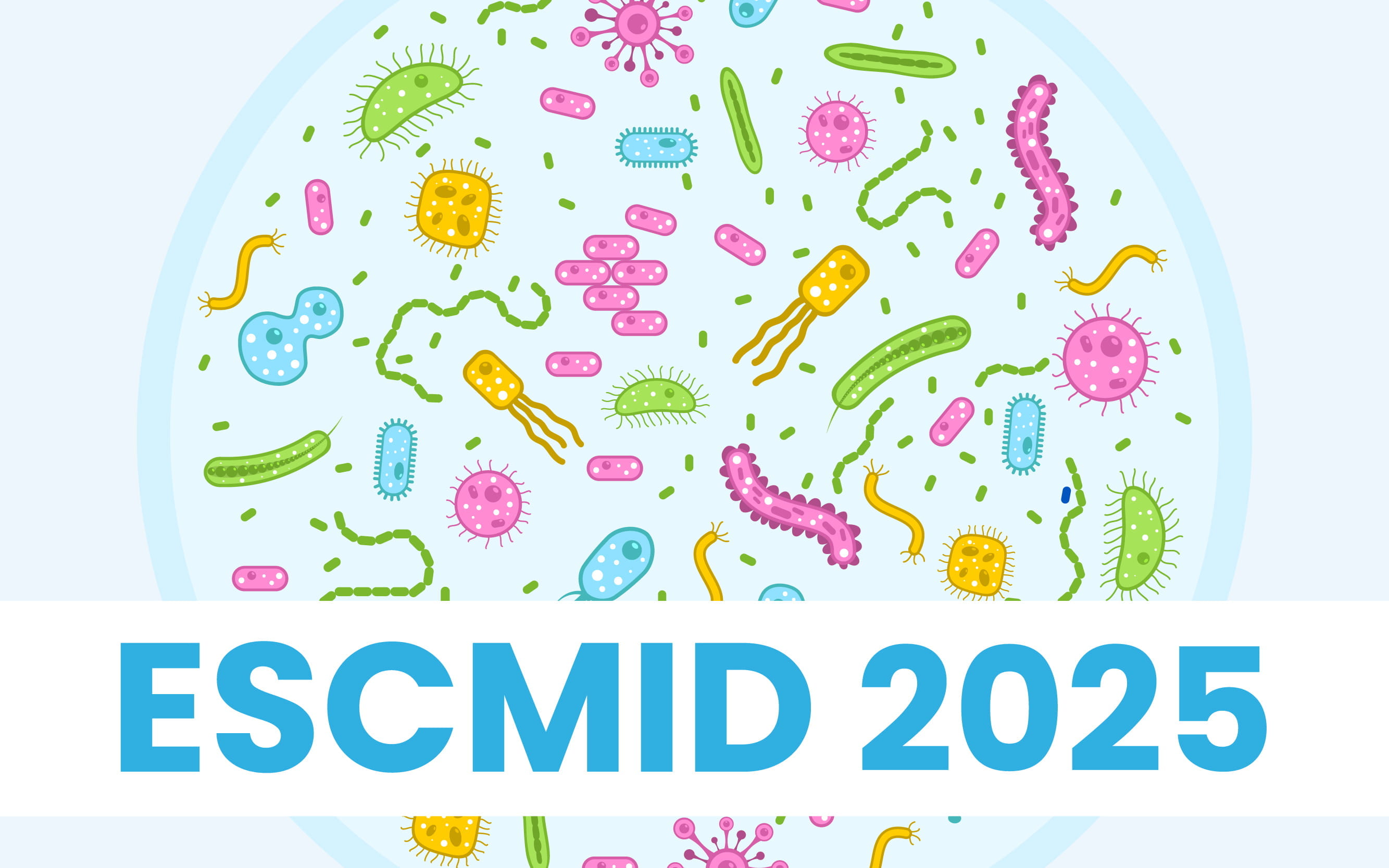ESCMID 2025: Carbapenem Resistance Gram-negatives, What's New in Treatment?
Sulbactam-Durlobactam as an Effective Alternative Option Against Ndm-Producing Escherichia Coli, Including Cefiderocol and Aztreonam-Avibactam-Resistant Isolates in Switzerland
Speaker: Dr. Christophe Le Terrier
Key Highlights
Introduction:
NDM (New Delhi metallo-β-lactamase)-producing Escherichia coli are recognized as a major global threat due to their resistance to nearly all β-lactam antibiotics. The efficacy of current treatments, including aztreonam-avibactam and cefiderocol, is increasingly being compromised by emerging resistance mechanisms.
Aim:
The study was conducted to assess the in vitro susceptibility of NDM-producing E. coli to SUL-DUR, particularly focusing on isolates resistant to cefiderocol and aztreonam-avibactam.
Methods:
-
Setting: The study was performed at the Swiss National Reference Center for Emerging Antibiotic Resistance.
-
Isolates: A total of 110 clinical E. coli isolates producing NDM (primarily NDM-5) were included.
-
Susceptibility Testing: MICs were determined for multiple agents, including SUL-DUR, durlobactam alone, cefiderocol, aztreonam-avibactam, tigecycline, and eravacycline.
-
Breakpoints: EUCAST and CLSI criteria were applied for interpretation; durlobactam was tested at a fixed concentration (4 mg/L) as per CLSI recommendations.
Results:
-
Aztreonam: Susceptibility was observed in only 12% of isolates.
-
Aztreonam-avibactam: Approximately 80% susceptibility was demonstrated.
-
Cefiderocol: Susceptibility rates varied between 34% (EUCAST) and 63% (CLSI).
-
Tigecycline and Eravacycline: Both showed >90% susceptibility but were noted to have clinical limitations.
-
SUL-DUR: Uniformly low MICs (≤0.06 mg/L) were recorded across all isolates, including those resistant to cefiderocol and aztreonam-avibactam.
-
Durlobactam Alone: MICs <2 mg/L were observed, suggesting intrinsic antibacterial activity.
Conclusion:
Potent in vitro activity of SUL-DUR against NDM-producing E. coli was demonstrated, including strains resistant to current first-line agents. The findings support further investigation of SUL-DUR as a potential treatment option for multidrug-resistant E. coli infections. However, clinical validation and pharmacokinetic/pharmacodynamic studies are required to confirm these promising in vitro results.
Optimising Fosfomycin-Based Combination Therapy for Difficult-To-Treat Gram-Negative Infections
Speaker: Dr. Tze-Peng LIM, Singapore
Key Highlights
Introduction:
Difficult-to-treat Gram-negative bacterial (DTR-GNB) infections are increasingly recognized as a major therapeutic challenge, particularly in high-resistance settings. The utility of fosfomycin-based combination therapies was investigated, with a focus on personalized treatment approaches guided by in vitro antibiotic combination testing (iACT).
Aim:
The study was conducted to assess clinical outcomes in adult inpatients treated with fosfomycin-containing combinations, with regimens being guided by iACT results.
Methods:
-
Setting: The study was performed at a 1,800-bed tertiary hospital in Singapore between 2017 and 2022.
-
Patient Selection: Forty-one patients with multidrug-resistant organisms (MDROs), including carbapenem-resistant Enterobacterales (CRE), Pseudomonas aeruginosa, and Acinetobacter baumannii, were included.
-
Testing Approach: A 96-well microdilution assay was utilized to test antibiotic combinations across multiple classes (aminoglycosides, polymyxins, cephalosporins, carbapenems, and fosfomycin).
-
Therapeutic Monitoring: Therapeutic drug monitoring (TDM) was performed in selected patients using an in-house assay.
Results:
-
Patient Characteristics: The median age of patients was approximately 60 years, with bloodstream infections (25%), intra-abdominal infections, osteomyelitis, and skin/soft tissue infections being the most common presentations.
-
Pathogen Profile: Predominantly NDM-producing Enterobacterales, including co-producers of OXA-48, were identified. Most isolates were classified as extensively drug-resistant (XDR).
-
Treatment Regimens: The most frequently used combinations included:
-
Fosfomycin + Aztreonam + Levofloxacin
-
Fosfomycin + Aztreonam
-
Fosfomycin + Levofloxacin
-
Fosfomycin + Meropenem
-
Clinical Outcomes: A 30-day all-cause mortality rate of 17% was observed. Microbiological eradication was achieved in all bloodstream infection cases.
-
Therapeutic Drug Monitoring: Significant interpatient variability in drug concentrations was noted, with therapeutic levels being achieved across different patient subgroups.
Conclusion:
The feasibility of personalized, fosfomycin-based combination therapy for DTR-GNB infections was demonstrated. Improved clinical outcomes were observed when treatment was guided by iACT and supported by TDM. However, the need for standardized protocols and larger validation studies was emphasized to confirm these findings. The importance of multidisciplinary collaboration and real-time diagnostic support was highlighted as critical for successful implementation.
Management of ST308 New Delhi Metallo-ß-Lactamase-Producing Pseudomonas Aeruginosa
Speaker: Dr. Jocelyn TEO, Singapore
Key Highlights
Introduction:
ST308 Pseudomonas aeruginosa strains harboring New Delhi metallo-β-lactamase (NDM) are recognized as a high-risk, extensively drug-resistant (XDR) clone. These pathogens pose significant therapeutic challenges due to resistance to nearly all β-lactams. A personalized approach utilizing in vitro combination testing (iACT) was evaluated to optimize therapy and reduce reliance on toxic agents like polymyxins.
Aim:
The study was conducted to:
-
Characterize the clinical features of ST308 NDM-producing carbapenem-resistant P. aeruginosa (CRPA) infections.
-
Assess the effectiveness of iACT-guided combination therapies in improving treatment outcomes.
Methods:
-
Setting: A prospective study was performed at a tertiary hospital in Singapore (2018–2022).
-
iACT Protocol: Up to 80 antibiotic combinations were tested using 96-well plates. Bactericidal activity was defined as ≥3 log reduction in CFU at 48 hours. Results were reported within 48 hours to guide timely therapy adjustments.
-
Therapeutic Drug Monitoring (TDM): TDM was utilized in select patients to ensure pharmacokinetic/pharmacodynamic (PK/PD) optimization.
Results:
-
Patient Cohort: Twenty-three patients with ST308 CRPA infections were included, predominantly presenting with bloodstream and urinary tract infections. Many had underlying malignancies, though only two were critically ill at baseline.
-
Resistance Profile: All isolates were classified as extensively drug-resistant, with intermediate susceptibility to aztreonam and susceptibility to cefiderocol (unavailable during the study).
-
Treatment Modifications:
-
Therapy was adjusted in 17 cases based on iACT results.
-
Polymyxin use was reduced due to toxicity concerns.
-
Aztreonam-based combinations (e.g., with cefepime or fosfomycin) demonstrated ~75% bactericidal activity in vitro.
-
Monotherapy was largely ineffective.
-
Outcomes:
-
Clinical success at therapy completion was achieved in 83% of cases.
-
Microbiological eradication was high, with only one reinfection documented.
-
In-hospital mortality was 13%.
-
Adverse drug reactions (ADRs) occurred in ~33% of patients, primarily electrolyte disturbances (IV fosfomycin) and nephrotoxicity (polymyxins).
Conclusion:
The effectiveness of iACT-guided combination therapy for ST308 NDM-producing CRPA infections was demonstrated. Polymyxin-sparing regimens, particularly aztreonam-based combinations, were found to be both effective and better tolerated. The importance of personalized, real-time testing in optimizing clinical outcomes and minimizing toxicity was highlighted. Further implementation of such strategies is recommended to enhance the management of these challenging infections.
In Vitro Activity of Cefepime/Enmetazobactam Against Enterobacterales in Portugal
Speaker: Dr. Hugo CRUZ, Portugal
Key Highlights
Introduction:
The in vitro efficacy of cefepime/enmetazobactam against clinical isolates of Enterobacterales was investigated by Dr. Hugo Cruz through a multicenter retrospective study. This novel β-lactam/β-lactamase inhibitor combination was assessed as a potential carbapenem-sparing option in antimicrobial stewardship programs, particularly for multidrug-resistant (MDR) Enterobacterales.
Aim:
The study was conducted to:
-
Evaluate the antimicrobial activity of cefepime/enmetazobactam against various Enterobacterales isolates
-
Compare its efficacy with piperacillin/tazobactam and meropenem
-
Assess its potential role in managing ESBL-producing and carbapenemase-producing strains
Methods:
-
Setting: Stored isolates were collected from three tertiary hospitals across Portugal (North, Central, and South regions)
-
Testing:
-
Minimum inhibitory concentrations (MICs) were determined using gradient diffusion testing
-
Results were interpreted according to EUCAST May 2024 guidelines (MIC cutoff ≤4 mg/L)
-
Pathogen Groups:
-
ESBL-producing Enterobacterales (primarily E. coli and K. pneumoniae)
-
ECK group (Enterobacter cloacae, Citrobacter freundii, K. aerogenes)
-
Carbapenemase-producing K. pneumoniae (KPC and OXA-48 producers; NDM producers excluded)
Results:
-
ESBL-Producing Enterobacterales (n=112)
-
Predominantly urinary tract isolates
-
Comparable susceptibility to meropenem was demonstrated
-
Superior activity over piperacillin/tazobactam was observed
-
Cefepime activity was restored by enmetazobactam in nearly all cases
-
ECK Group Enterobacterales (n=90)
-
Primarily respiratory isolates
-
High activity similar to meropenem was shown
-
Most isolates were likely AmpC producers
-
The limitations of piperacillin/tazobactam monotherapy were confirmed
-
Carbapenemase-Producing K. pneumoniae (n=103)
-
Promising susceptibility rates were demonstrated:
-
80% in KPC-producers
-
84% in OXA-48 producers
-
No activity against NDM-producing strains was observed
Conclusion:
High in vitro activity of cefepime/enmetazobactam against ESBL-producing, AmpC-producing, and selected carbapenemase-producing Enterobacterales was demonstrated. The combination was identified as a potential carbapenem-sparing alternative, particularly where piperacillin/tazobactam is ineffective. However, the need for clinical correlation studies was emphasized, especially for carbapenemase-producing strains. The importance of reserving ceftolozane/tazobactam for Pseudomonas infections was highlighted, given emerging resistance patterns in Portugal.
ESCMID Global, 11–15 April 2025, Vienna


